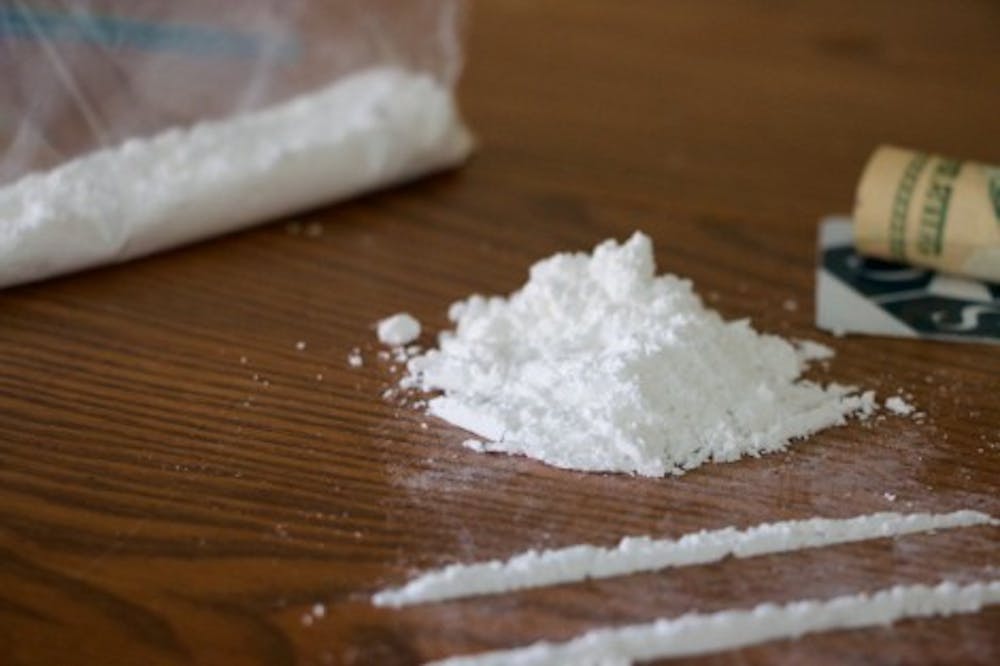By ALEX DRAGONE
Cocaine, widely thought of as a hardcore drug, has a subtle presence on the Homewood Campus.
A student who uses cocaine, who wished to remain anonymous, spoke about his experiences. The student said he uses cocaine solely on the weekends in social settings.
“It makes you feel very social and confident,” the student said. “You just want to talk and make friends. It’s like a firework goes off in the middle of my brain. You just feel euphoria.”
Cocaine is a stimulant, giving a temporary increase in mental function. Levels of dopamine, a neurotransmitter, increase with pleasurable experiences and function as part of the brain’s reward system.
Cocaine prevents neurons from reabsorbing the dopamine, leading to above-average levels of the chemical circulating in the brain and producing a sensation of happiness, excitement and friendliness.
Cocaine is typically administered by snorting powder, which is rapidly absorbed into the bloodstream and sent to the brain.
A typical high from snorting cocaine will last anywhere from 15 to 30 minutes, according to the National Institute of Drug Abuse, or up to an hour, according to the student. Crack cocaine, a variant which uses crystals as opposed to powder, is smoked and results in a more intense and shorter high of five to ten minutes.
Because cocaine produces short highs, the anonymous student said that if he uses the drug, he will use it multiple times throughout the night.
“I’d start the night with maybe 100 mg.,” the student said. “If I’ve been drinking that will affect it. If I’ve been smoking weed that will affect it... and from there I’ll be doing 50 mg. to 100 mg. lines every 30 minutes to an hour... I’d probably do that four or five times in a night. The more you do, the more each successive line lasts.”
Director of the Student Health and Wellness Center Dr. Alain Joffe discussed his experience with cocaine use on campus.
“We occasionally, but not commonly, see students who admit to cocaine use, but it’s not very many,” Joffe wrote in an email to The News-Letter. “It’s hard to know if the numbers using are really low or if students are reluctant to disclose use in contrast to alcohol and marijuana, which students seem quite comfortable discussing.”
4.4 percent of college students reported using cocaine in 2014, according to a report on drug use authored by the University of Michigan’s Institute for Social Research.
Students thought that cocaine was not a very common drug on campus.
“I think that the Hopkins student body is divided into different social groupings,” senior Ian Anderson said. “Those people always interact with that group of people. So for some, they will absolutely not use cocaine. But in other groups a lot of people use it... on average it’s low.”
“I’d want to say between one and 10 and one and 20 has tried [cocaine],” the anonymous student said. “Of those, about one in 50 still does it regularly.”
The student said he could name at least 15 people on campus who use cocaine. The student said no one he knew was addicted to the drug.
Most of the cocaine circulating is sold to students from dealers native to Baltimore.
“A lot of people around here will cut their stuff with focalin [a stimulant used to treat ADHD]. It makes it last longer. The stuff I buy is cut with inositol [a vitamin]; it’s kind of sweet. Sometimes people cut with baking soda,” said the student.
Dealers add other substances to the pure cocaine powder to make it appear as if there is a larger quantity. Street-bought cocaine will typically have a pure cocaine content of around 50 percent.
The student said every few months he buys an eighth of an ounce of cocaine, or 3.5 grams, usually costing around $200.
Medical resources such as the National Institute of Drug Abuse call cocaine a “powerfully addictive stimulant drug,” and a widely held perspective among students is that cocaine is more addictive than substances like marijuana, alcohol and tobacco.
“I’m assuming it is [very addictive],” senior Dani Dinstein said. “I’d guess one or two hits,” she said when asked to estimate how much usage it would take to become addicted to cocaine.
The anonymous student disagreed.
“It’s not as bad as they say. I can see how it can be addictive when you’re on it, but I don’t think it’s addictive in the same way cigarettes are addictive,” the student said. “Opiates I’ve felt at risk [of addiction]. Opiates are addictive as f**k. That’s something I have trouble stopping when I do them. Cigarettes I have trouble stopping when I do them. Cocaine’s never really been an issue. I can stop for months at a time, I can do it three nights in a row. It’s no different of an urge for me than the urge to drink or go work out.”
The student contrasted alcohol and marijuana use to cocaine use.
“Cocaine is not like weed or alcohol in that it alters your perceptions of reality,” the student said. “It just makes you really happy and makes you really energetic. You can do a whole bunch of cocaine and your thoughts are fine. They’re fast, but they’re completely normal... Some people are underwhelmed after their first time.”
The student stressed the importance of accurate education about drugs.
“Whether you’re a drug user or not you should know how drugs affect the body and how people on drugs really are,” the student said. “Everyone knows a drug user. And you should educate yourself on how these drugs affect the body and the truth behind them. Because everything we learned in school just isn’t true. Drug education is so negative, and they do such a bad job with this abstinence training. They tell people that cocaine is the most addictive thing in the world. And then someone tries it and finds out that it’s not, and then the question comes to mind, ‘Well, what is true?’”
The student also related his perception that Hopkins students would judge him if they knew he has used cocaine.
“I would not want to be judged if someone knew I did cocaine,” the student said. “Because I don’t think it’s something I need to be judged for. But I know people would, so it’s something that I have to keep hidden. And I think it’s ridiculous.”





